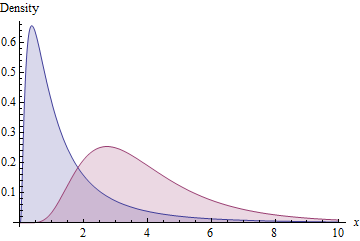Since data never have lognormal distributions, let's analyze lognormal random variables and then come back to the question of data.
Suppose, then, that $X$ is a random variable with a lognormal distribution. By definition this means $Y=\log(X)$ is almost surely defined and has a Normal$(\mu,\sigma^2)$ distribution for some parameters $\mu$ and $\sigma \gt 0$. In terms of these parameters,
$$E[X] = e^{\mu + \sigma^2/2}$$
and
$$\operatorname{Var}(X) = E[X]^2\left(e^{\sigma^2}-1\right) = e^{2\mu + \sigma^2}\left(e^{\sigma^2}-1\right).$$
(See https://stats.stackexchange.com/a/116657/919 for a derivation.)
We have a great many options to transform $X$ into a new variable $X^\prime$. Among these, the simplest and most natural will correspond to affine transformations of $Y$ to $Y^\prime = \log(X^\prime)$; that is, suppose
$$Y^\prime = a Y + b$$
for some numbers $a$ and $b$, which we proceed to find. In this case the distribution of $Y^\prime$ is still Normal with parameters $$\mu^\prime = a\mu + b$$ and $$(\sigma^\prime)^2 = a^2\sigma^2.$$
Therefore
$$E[X^\prime] = e^{\mu^\prime +(\sigma^\prime)^2/2} = e^{a\mu +b + a^2\sigma^2/2}.$$
Moreover, we want the new variance to be the same as the old, whence
$$e^{2\mu + \sigma^2}\left(e^{\sigma^2}-1\right) = \operatorname{Var}(X) = \operatorname{Var}{X^\prime} = e^{2(a\mu+b) + a^2\sigma^2}\left(e^{a^2\sigma^2}-1\right).$$
Typically there are no solutions (if $E[X^\prime]$ is too small) or two solutions. Writing $m=\log E[X^\prime]$ for the logarithm of the target mean, let
$$d = \log\left(1 - e^{\sigma^2 - 2m + 2\mu} + e^{2\sigma^2 - 2m + 2\mu}\right).$$
Then there is a solution provided $d \ge 0$ and the solution(s) are
$$a = \pm\frac{\sqrt{d}}{\sigma};\quad b = m - \mu a - \frac{d}{2}.$$
Finally, note that the transformation can be expressed directly in terms of $X$ as
$$X^\prime = e^{Y^\prime} = e^{aY + b} = e^{a\log(X)+b} = e^b X^a.$$
It rescales a power of $X$.
As an illustration, the blue area shows the density function of a Lognormal$(0,1)$ distribution while the red area shows that of a Lognormal distribution with the same standard deviation and mean of $e^m=4$.

Finally, you might consider applying a comparable transformation to the data: to the extent the data look like they come from a lognormal distribution, this scaled power transformation will produce a new dataset that also looks lognormally distributed with a parent distribution of the same standard deviation. Accordingly, the new data should have almost the same SD as the original data--but, depending on how you estimate the parameters of the parent distribution, the SDs might not exactly be the same.

